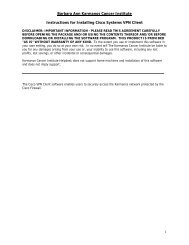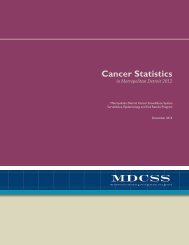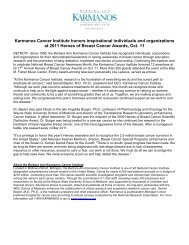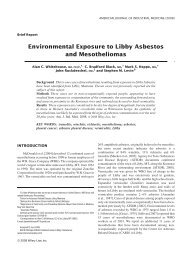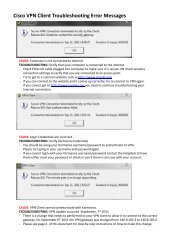Cancer Statistics - Karmanos Cancer Institute
Cancer Statistics - Karmanos Cancer Institute
Cancer Statistics - Karmanos Cancer Institute
You also want an ePaper? Increase the reach of your titles
YUMPU automatically turns print PDFs into web optimized ePapers that Google loves.
Gender Differences in Lung <strong>Cancer</strong> Survival<br />
Investigator: Michele L. Cote, PhD<br />
Lung cancer is the leading cause of cancer<br />
death in the United States. 1 It is estimated that<br />
in 2005, 172,570 individuals in the United<br />
States were diagnosed with lung cancer, and<br />
163,510 died of the disease. 1 Men are more<br />
likely to be diagnosed with lung cancer than<br />
women. In 2002, the age-adjusted incidence<br />
rates of lung cancer were 77.8 cases per<br />
100,000 men, and 50.8 cases per 100,000<br />
women. 2 Only prostate cancer in men and breast cancer in women<br />
were diagnosed more often. Survival from lung cancer is poor, with<br />
a five-year survival rate of 13.6% for men and 17.5% in women<br />
from 1995-2001. 2 Approximately 6 in 10 individuals with lung<br />
cancer die within a year of diagnosis. 1 Survival is greater for women<br />
than for men at every stage of diagnosis. Little is known about<br />
gender-related differences in risk and survival.<br />
Current or former cigarette smoking remains the greatest risk<br />
factor for lung cancer development, yet women are more likely to<br />
report never smoking than men, and also tend to smoke less than<br />
their male counterparts. 3 Histologic type of lung cancer varies by<br />
gender as well, with women more likely to develop adenocarcinomas<br />
compared to men. 4 Evidence suggests these differences could be<br />
due, in part, to hormonal variation and exposure to estrogens. 5<br />
Women have higher circulating endogenous levels of estrogen compared<br />
to men, and are also exposed to synthetic estrogens through<br />
hormone replacement therapy and oral contraceptives. Estrogens<br />
can increase cell proliferation. 6 Estrogens may also increase lung<br />
cancer risk by modulating gene expression of other enzymes, particularly<br />
the polycyclic aromatic hydrocarbon metabolizing enzymes<br />
such as the cytochrome p450s. 7 Several other genes thought to<br />
increase risk of lung cancer, including the c-erbB2 receptor, are also<br />
activated by estrogens. 8 Cellular response to estrogens is mediated<br />
by estrogen receptors (ER). Two receptors, ER-α and ER-β, which<br />
are encoded by separate genes have been identified and are expressed<br />
in the lung. It is feasible that ER status plays a role in lung<br />
carcinogenesis, may impact survival, and may be a potential target<br />
for therapy.<br />
We have recently received funding by the National Lung <strong>Cancer</strong><br />
Partnership and the LUNGevity Foundation to examine the effect<br />
of ER expression on survival after a lung cancer diagnosis. We seek<br />
to clarify whether ER status and aromatase expression is associated<br />
with prognosis and may serve as therapeutic targets. Targeting<br />
hormone receptors has been successful in both chemoprevention<br />
and treatment in a variety of cancers. The role hormones play in<br />
lung cancer prognosis in humans has yet to be fully explored. These<br />
analyses will aid in the understanding of the underlying biological<br />
processes of lung cancer, and potentially lead to novel targets for<br />
treatment of lung cancer.<br />
PERCENTAGE<br />
25<br />
20<br />
15<br />
10<br />
5<br />
References:<br />
5 Year Relative Survival Rates for Lung <strong>Cancer</strong><br />
by Gender in Metropolitan Detroit, 1973 – 2004<br />
1975 1980 1985 1990 1995<br />
YEAR DIAGNOSED - 3 YEAR MOVING AVERAGE<br />
Female<br />
Male<br />
2000<br />
2000<br />
1. American <strong>Cancer</strong> Society I. Key <strong>Statistics</strong> for Lung <strong>Cancer</strong>, 2004<br />
2. Ries LAG EM, Kosary CL, Hankey BF, Miller BA, Clegg L, Mariotto A, Feuer EJ,<br />
Edwards BK (eds). SEER <strong>Cancer</strong> <strong>Statistics</strong> Review, 1975-2002. In: Ries LAG EM,<br />
Kosary CL, Hankey BF, Miller BA, Clegg L, Mariotto A, Fay MP, Feuer EJ, Edwards<br />
BK (eds). ed: National <strong>Cancer</strong> <strong>Institute</strong>. Bethesda, MD, 2005<br />
3. (CDC) CfDCaP. Behavioral Risk Factor Surveillance System Survey Data.<br />
In: Services USDoHaH, ed. Atlanta, Georgia, 2003<br />
4. Charloux A, Quoix E, Wolkove N, et al. The increasing incidence of lung<br />
adenocarcinoma: reality or artefact? A review of the epidemiology of lung<br />
adenocarcinoma. Int J Epidemiol 1997; 26:14-23.<br />
5. Taioli E, Wynder EL. Re: Endocrine factors and adenocarcinoma of the lung<br />
in women. J Natl <strong>Cancer</strong> Inst 1994; 86:869-870<br />
6. Ethier SP. Growth factor synthesis and human breast cancer progression.<br />
J Natl <strong>Cancer</strong> Inst 1995; 87:964-973<br />
7. Thomsen JS, Wang X, Hines RN, et al. Restoration of aryl hydrocarbon (Ah)<br />
responsiveness in MDA-MB-231 human breast cancer cells by transient expression<br />
of the estrogen receptor. Carcinogenesis 1994; 15:933-937<br />
8. Matsuda S, Kadowaki Y, Ichino M, et al. 17 beta-estradiol mimics ligand activity<br />
of the c-erbB2 protooncogene product. Proc Natl Acad Sci U S A 1993;<br />
90:10803-10807<br />
* Source: Surveillance, Epidemiology, and End Results (SEER) Program<br />
(www.seer.cancer.gov) SEER*Stat Database: Incidence - SEER 17 Regs Limited-Use,<br />
Nov 2006 Sub (1973-2004 varying) - Linked To County Attributes - Total U.S.,<br />
1969-2004 Counties, National <strong>Cancer</strong> <strong>Institute</strong>, DCCPS, Surveillance Research<br />
Program, <strong>Cancer</strong> <strong>Statistics</strong> Branch, released April 2007, based on the November<br />
2006 submission.<br />
19




